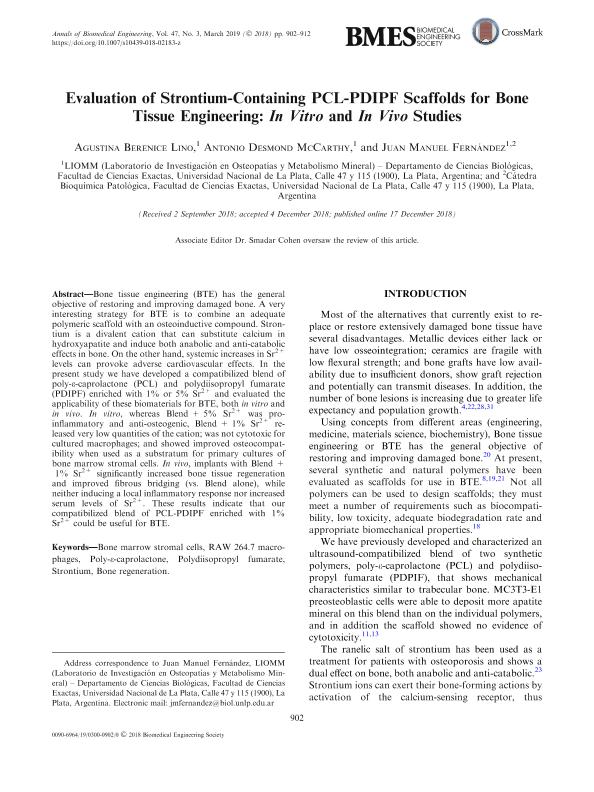Mostrar el registro sencillo del ítem
dc.contributor.author
Lino, Agustina Berenice

dc.contributor.author
McCarthy, Antonio Desmond

dc.contributor.author
Fernández, Juan Manuel

dc.date.available
2021-05-12T17:56:57Z
dc.date.issued
2018-12
dc.identifier.citation
Lino, Agustina Berenice; McCarthy, Antonio Desmond; Fernández, Juan Manuel; Evaluation of strontium-containing PCL-PDIPF scaffolds for bone tissue engineering: In vitro and in vivo studies; Springer; Annals Of Biomedical Engineering; 47; 3; 12-2018; 902-912
dc.identifier.issn
0090-6964
dc.identifier.uri
http://hdl.handle.net/11336/131911
dc.description.abstract
Bone tissue engineering (BTE) has the general objective of restoring and improving damaged bone. A very interesting strategy for BTE is to combine an adequate polymeric scaffold with an osteoinductive compound. Strontium is a divalent cation that can substitute calcium in hydroxyapatite and induce both anabolic and anti-catabolic effects in bone. On the other hand, systemic increases in Sr 2+ levels can provoke adverse cardiovascular effects. In the present study we have developed a compatibilized blend of poly-ε-caprolactone (PCL) and polydiisopropyl fumarate (PDIPF) enriched with 1% or 5% Sr 2+ and evaluated the applicability of these biomaterials for BTE, both in vitro and in vivo. In vitro, whereas Blend + 5% Sr 2+ was pro-inflammatory and anti-osteogenic, Blend + 1% Sr 2+ released very low quantities of the cation; was not cytotoxic for cultured macrophages; and showed improved osteocompatibility when used as a substratum for primary cultures of bone marrow stromal cells. In vivo, implants with Blend + 1% Sr 2+ significantly increased bone tissue regeneration and improved fibrous bridging (vs. Blend alone), while neither inducing a local inflammatory response nor increased serum levels of Sr 2+ . These results indicate that our compatibilized blend of PCL-PDIPF enriched with 1% Sr 2+ could be useful for BTE.
dc.format
application/pdf
dc.language.iso
eng
dc.publisher
Springer

dc.rights
info:eu-repo/semantics/openAccess
dc.rights.uri
https://creativecommons.org/licenses/by-nc-sa/2.5/ar/
dc.subject
BONE MARROW STROMAL CELLS
dc.subject
BONE REGENERATION
dc.subject
POLY-Ε-CAPROLACTONE
dc.subject
POLYDIISOPROPYL FUMARATE
dc.subject
RAW 264.7 MACROPHAGES
dc.subject
STRONTIUM
dc.subject.classification
Biomateriales

dc.subject.classification
Biotecnología de la Salud

dc.subject.classification
CIENCIAS MÉDICAS Y DE LA SALUD

dc.title
Evaluation of strontium-containing PCL-PDIPF scaffolds for bone tissue engineering: In vitro and in vivo studies
dc.type
info:eu-repo/semantics/article
dc.type
info:ar-repo/semantics/artículo
dc.type
info:eu-repo/semantics/publishedVersion
dc.date.updated
2021-05-11T18:25:59Z
dc.journal.volume
47
dc.journal.number
3
dc.journal.pagination
902-912
dc.journal.pais
Alemania

dc.journal.ciudad
Berlin
dc.description.fil
Fil: Lino, Agustina Berenice. Universidad Nacional de La Plata. Facultad de Ciencias Exactas. Departamento de Ciencias Biológicas. Laboratorio de Investigación en Osteospatías y Metabolismo Mineral; Argentina. Consejo Nacional de Investigaciones Científicas y Técnicas. Centro Científico Tecnológico Conicet - La Plata; Argentina
dc.description.fil
Fil: McCarthy, Antonio Desmond. Universidad Nacional de La Plata. Facultad de Ciencias Exactas. Departamento de Ciencias Biológicas. Laboratorio de Investigación en Osteospatías y Metabolismo Mineral; Argentina
dc.description.fil
Fil: Fernández, Juan Manuel. Universidad Nacional de La Plata. Facultad de Ciencias Exactas. Departamento de Ciencias Biológicas. Laboratorio de Investigación en Osteospatías y Metabolismo Mineral; Argentina. Consejo Nacional de Investigaciones Científicas y Técnicas. Centro Científico Tecnológico Conicet - La Plata; Argentina
dc.journal.title
Annals Of Biomedical Engineering

dc.relation.alternativeid
info:eu-repo/semantics/altIdentifier/doi/http://dx.doi.org/10.1007/s10439-018-02183-z
dc.relation.alternativeid
info:eu-repo/semantics/altIdentifier/url/https://link.springer.com/article/10.1007%2Fs10439-018-02183-z
Archivos asociados
